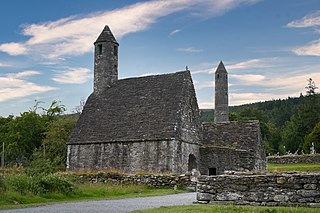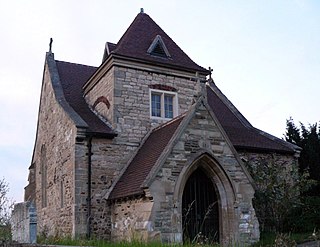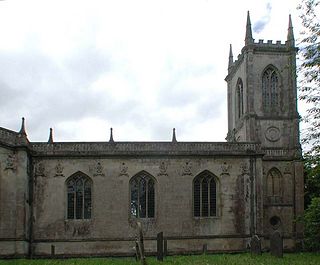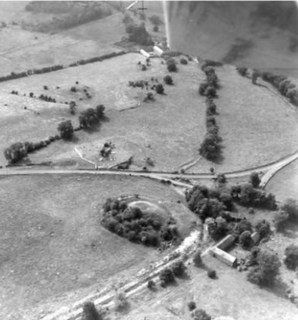
Glendalough is a glacial valley in County Wicklow, Ireland, renowned for an Early Medieval monastic settlement founded in the 6th century by St Kevin. From 1825 to 1957, the head of the Glendalough Valley was the site of a galena lead mine. Glendalough is also a recreational area for picnics, for walking along networks of maintained trails of varying difficulty, and also for rock-climbing.

Turweston is a village and civil parish in north-west Buckinghamshire, England. The village is beside the River Great Ouse, which bounds the parish to the north, west and south. Turweston is the most northwesterly parish in Buckinghamshire: the Ouse here forms the county boundary with Northamptonshire to the north and west and Oxfordshire to the south. Across the river, the Northamptonshire market town of Brackley is just west of Turweston, with the town centre about 1 mile (1.6 km) west of the village. The parish has an area of 1,295 acres (524 ha) and had a population of 211 at the 2011 Census.

The Cathedral Church of St. Brigid, Kildare, in Kildare, County Kildare, is one of two cathedrals in the United Dioceses of Meath and Kildare of the Church of Ireland in Ireland. It is in the ecclesiastical province of Dublin.

St Michael's Church is located by the side of the River Derwent in the dispersed settlement of Isel, in the civil parish of Blindcrake, Cumbria, England. It is an active Anglican parish church in the deanery of Derwent, the archdeaconry of West Cumberland, and the diocese of Carlisle. Its benefice is united with those of nine local churches to form the benefice of Binsey. The church is recorded in the National Heritage List for England as a designated Grade I listed building.

St Oswald's Church is a redundant Anglican church in Kirk Sandall, near Doncaster, South Yorkshire, England. It is recorded in the National Heritage List for England as a designated Grade II* listed building, and is under the care of the Churches Conservation Trust.

St Michael's Church is a redundant Anglican church in Tretire with Michaelchurch, Herefordshire, England. It is recorded in the National Heritage List for England as a designated Grade II listed building, and is under the care of the Churches Conservation Trust. It is in an isolated position in a field some 5 miles (8 km) to the west of Ross-on-Wye. The church is notable for its 13th-century wall paintings, and the presence of a reconstructed Roman altar.

All Saints Church is a redundant Anglican church in the parish of Chadshunt, Warwickshire, England. It is recorded in the National Heritage List for England as a designated Grade II* listed building, and is under the care of the Churches Conservation Trust. It stands by the side of the road from Kineton to Southam. Its general appearance is "long, low and massive".

St Michael and All Angels Church is a redundant Anglican church in the village of Edmondthorpe, Leicestershire, England. It is recorded in the National Heritage List for England as a designated Grade I listed building, and is under the care of the Churches Conservation Trust.

The Parish Church of Saint Matthew, Langford is the Church of England parish church of Langford, a village in West Oxfordshire about 3 miles (5 km) northeast of Lechlade in neighbouring Gloucestershire.

St Mary Magdalene's Church is a redundant Anglican church near the village of Stapleford, Leicestershire, England. It is recorded in the National Heritage List for England as a designated Grade I listed building, and is under the care of the Churches Conservation Trust. It is situated in the grounds of Stapleford Park.

St Martin's Church is a redundant Anglican church in the village of Waithe, Lincolnshire, England. It is recorded in the National Heritage List for England as a designated Grade I listed building, and is under the care of the Churches Conservation Trust. It stands in open countryside near the A16 road between Grimsby and Louth.

St Nicholas Church is a redundant Anglican church in Normanton-on-Cliffe, Lincolnshire, England. It is recorded in the National Heritage List for England as a designated Grade II* listed building, and is under the care of the Churches Conservation Trust. It stands beside the road between Grantham and Lincoln.

St Mary's Church is a redundant Anglican round-tower church near the village of Moulton St Mary, Norfolk, England. It is recorded in the National Heritage List for England as a designated Grade I listed building, and is under the care of the Churches Conservation Trust. It stands some 4 kilometres (2 mi) to the south of Acle in an isolated position adjacent to a farm.

All Saints Church is a redundant Anglican church in the village of Little Wenham, Suffolk, England. It is recorded in the National Heritage List for England as a designated Grade I listed building, and is under the care of the Churches Conservation Trust. It stands in an isolated position close to Little Wenham Hall, about 0.6 miles (1 km) to the northwest of Capel St. Mary.

St. Mary's Church is a historic Anglican church in the hamlet of Ashley, Hampshire, England. It is recorded in the National Heritage List for England as a designated Grade II* listed building, and is under the care of The Churches Conservation Trust. The church stands adjacent to the site of the former Gains Castle, some 4 miles (6 km) southeast of Stockbridge.

St Mary's Church is a redundant Anglican church in the village of Pitstone, Buckinghamshire, England. It is recorded in the National Heritage List for England as a designated Grade I listed building, and is under the care of the Churches Conservation Trust. The church stands to the southeast of the village, some 9 miles (14 km) east of Aylesbury.

St Peter's and St Paul's Church is a parish church in Yalding, Kent, dedicated to saints Peter and Paul. It was begun in the 13th century and is a Grade I listed building.

St Edith's Church is in the village of Eaton-under-Heywood, Shropshire, England. It stands on the lower slopes of Wenlock Edge. The church, dedicated to Saint Edith of Wilton, is an active Anglican parish church in the deanery of Condover, the archdeaconry of Ludlow, and the diocese of Hereford. Its benefice is united with that of St Andrew, Hope Bowdler. The church is recorded in the National Heritage List for England as a designated Grade I listed building.

Lickbla, is a historic monument, civil parish, religious parish, and townland, in County Westmeath, Ireland. It is located about 23.05 kilometres (14 mi) north of Mullingar. St. Bladma is listed in the Martyrology of Oengus as a saint: "Bladma, i.e. from Blad son of Conmac Cas Clothach, grandson of Tachall son of Cermait, son of the Dagda, a quo nominatur. Or Blad son of Breogan, a quo Sliab Bladma" whose feastday is 7 April and 20 November.

St Margaret's Church is a 13th-century Church of England church in the village of Whaddon, Gloucestershire, England. It has been a grade II* listed building since 10 January 1955. The church tower is a dominant feature within the surrounding flat area.





















